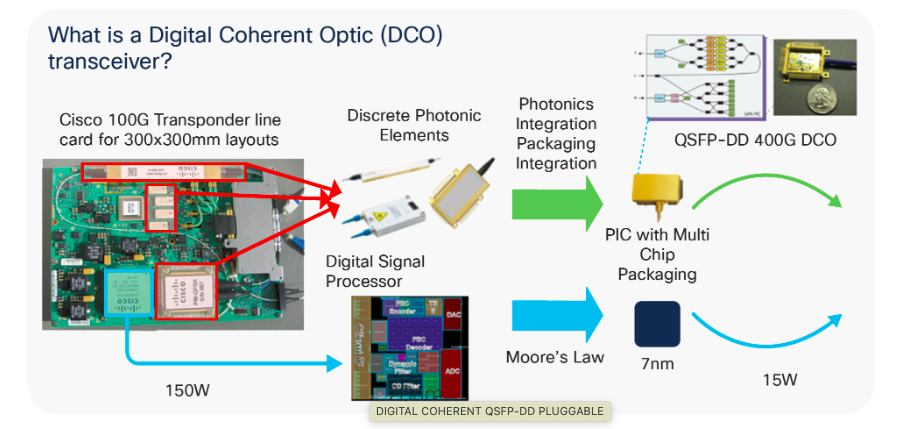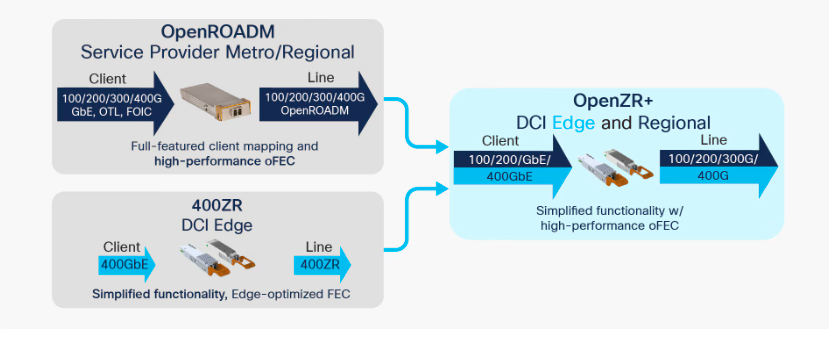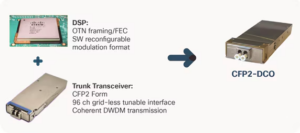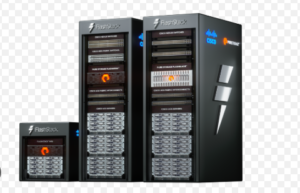Cisco offers a comprehensive range of pluggable optical modules in the Cisco® pluggables portfolio. The wide variety of modules gives you flexible and cost-effective options for all types of interfaces. Cisco offers a range of GBIC, SFP, XFP, SFP+, CXP, CFP, Cisco CPAK, and QSFP+ pluggable modules. These small, modular optical interface transceivers offer a convenient and cost-effective solution for an array of applications in the data center, campus, metropolitan-area access and ring network, storage area network, and long-haul network. In recent times, with longer strides of innovation, Cisco has introduced analog DWDM CFP2 interfaces to the market. The latest addition to the Cisco portfolio pushes this boundary further with the introduction of the 400G DIGITAL COHERENT QSFP-DD PLUGGABLE OPTICAL MODULE.

Product overview
Cisco now offers a range of all new 400G Digital Coherent QSFP-DD transceivers. Cisco already offers a range of Digital Coherent CFP2 transceivers capable of supporting up to a 200-Gbps wavelength. Thanks to the miniaturization of the technology with a 7-nm manufacturing procedure and innovation in silicon photonic technology, it is now possible to squeeze a 400G-capable Digital Coherent WDM interface within a QSFP-DD form factor.
Two product variants are available:
1. ZR variant
2. ZR Plus variant
QDD ZR overview
The QSFP-DD ZR variant complies with OIF MSA, allowing to provide compatibility with the equivalent component compliant with the same MSA standard. The key application for the ZR standard is allowing the transmission of a 400G wavelength in point-to-point topology up to a distance of 120 km with the Mux/Demux and Amplifier as depicted the below.

As line card ports become universal, it is possible to design new line cards optimized for 400G, knowing that by simply replacing the pluggable, the port can support bitrates down to 100G to guarantee backward compatibility with previous-generation routers. In addition, the IPoDWDM options, available by simply using the 400G ZR/ZR+ optics, provides, for the first time, the same density of grey line cards, eventually solving the usual dilemma of having to choose between the benefits of integration and maximizing the throughput of router line cards.
Some network operators chose to take a different approach at 400G upon recognizing the lessons learned from the efforts at 100G. In late 2016, these network operators and a few vendors identified 400G as an intersection point for the industry to support coherent optics in the same form factors as emerging high-volume client optics, such as QSFP-DD. In less than one year, the OIF defined most of the 400ZR interface technical details, which helped motivate increased industry investment in pluggable, interoperable coherent interfaces.
A key requirement was to accommodate hyperscale DCI links beyond 120 km, while maintaining the same QSFP-DD/OSFP form factors. A survey of 400G standardization efforts pointed to elements of OpenROADM that could provide a standard-based, high-performance addition to the 400ZR standard. Thus, the industry began looking at the next logical step, which would be to combine these vetted specifications and achieve the goal of addressing 400G Ethernet-centric solutions beyond 120 km. This would enable the extension of hyperscale DCIs beyond the edge to regional distances, and expand the addressable market for module suppliers, providing greater economies of scale that benefit the entire distribution chain. This combination of the 400ZR standard with elements of OpenROADM became known as OpenZR+.
QDD ZR Plus overview
The QSFP-DD ZR Plus variant complies with OpenZR+ MSA, allowing to cope for distances going from regional to long haul with multiple amplification sites between the end point. This variant is also providing multiple configuration options in terms of Modulation scheme, TX filter shaping, and baud rates on top of what OpenZR+ MSA defines.
This variant is also the one capable of reaching the longest transmission distance thanks to the high-performing O-FEC algorithm.
It is able to support an ~60G baud rate, QPSK, and 8-QAM and 16-QAM modulation scheme to cope with a 200G (QPSK), 300G (8-QAM), and 400G (16-QAM) per wavelength transmission capacity.
It is also capable of supporting 100G signals leveraging QPSK modulation scheme at ~30G baud as well as 200G signal at 16-QAM (~30Gbaud) and 8-QAM (~40 Gbaud).
From the signal shaping mode of view, two different configurations are supported (with or without Tx shaping) to cope with different filtering requirements.




